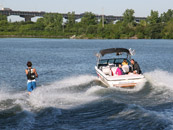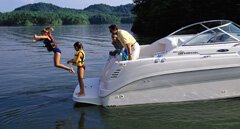
The start of water ski season, a glorious time of year when anything is possible. A new PB (personal best) on the course, a new barefoot trick, the first trip off a jump — it’s all within reach. The time when an injury, a boat breakdown or the kids’ busy activities schedule have not yet shattered the illusion of skiing several days a week. Excited yet? From proper pulling position to adjusting your gear, here’s what you need to know to start the season ahead of the curve.
Less Muscle Equals More Direction
When you round a buoy, let your body’s natural falling motion roll your ski on edge. The amount of edge created here is the maximum sustainable angle you can take to the next buoy. As your free hand connects back onto the handle, feel your arms fall away from your body. This allows your body to freely extend away from the ski edge, creating maximum angle that you can manage. I see most people coming out of the buoy with their elbows and biceps pulled tight. All that work merely holds your body up, reducing ski angle and reducing direction to the next buoy. If you let your arms out and push them down, your body will go farther away from the handle. Hence, you get more sustainable ski angle with considerably less muscular attack. — Chris Rossi, proskicoach.com
Angle of Attack: Set It and Forget It
Keep Teaching
Kids can get set in their ways very quickly. If kids get too comfortable in one spot, they won’t try anything new. When kids are solid on two skis, can cross the wake and can lift one foot then the other to show balance, then I like to let them try to get up on one ski on the boom. I recommend teaching your kids to get up on one ski versus dropping a ski. If you continue to introduce new things, kids can learn quickly. We have 5-year-olds running the slalom course, and parents sometimes don’t think that’s possible, but it is. It’s because that’s what the kid has been exposed to, and that’s what they know they can do, so they go do it. — April Coble Eller, Coble Ski School
Find Your Rhythm
Many skiers are afraid they are going to be too fast or too narrow in the course. For example, if a skier is going too fast into a buoy, they are afraid to make a good turn because they won’t be able to handle the speed. To fix it, I try to get them in a rhythm, like a child on a swing set. When they get to the buoy, they are reaching their highest point, widthwise, and they are also reducing their speed. Everybody I teach, I try to get them to feel wide and slow and balanced at the buoy, because that’s really the only thing that tastes good in slalom. By reaching the apex of your turn at the buoy, you can eliminate much of the fear associated with speed or width in the course. — Chet Raley, Palm Beach Training Center
One Step at a Time
To start learning new things, it’s a good idea to get back to basics, especially early in the year. Even at ski school, we back people up in order to move them forward. You will only be able to improve so much if you don’t have good fundamentals. Always start with a solid base before working on the next trick. Then, we use a progressive learning approach, starting with simple tricks that have the least amount of risk. In barefoot, if you can do a deepwater start and you can’t tumble, the next step is probably a tumble turn. If you can one-foot, the next trick is a toe hold. Gradually increasing the difficulty will help you learn new tricks, and learn them with solid fundamentals. — Ron Scarpa, Ron Scarpa Watersports
Adjust With Ease
A little adjustment to your ski can go a long way. I always do the easiest thing first, which is to adjust the bindings. Moving the binding forward will help you solve the common problem of riding too far back on the ski. If I’m in the boat and have already moved the binding as far forward as it will go, then I’ll take a look at the wing. If I have 5 degrees on the wing and still need more tip in the water, I’ll move it to 7 degrees. If I still need more, I will go to 9 or even 11 degrees. If that doesn’t work, I’ll go to the fin — but be careful. Once you start moving the fin, you get into infinite settings. Bottom line: Always do the easiest thing first, and adjust one thing at a time so you can easily move it back. — Steve Schnitzer, schnitzskis.com
Check Your Gear
Before you hit the water, take a good look at the rope. Breaking a rope during a slalom run is a good way to break a rib. You want to make sure there is no fraying around the knots or other weak spots in the line. It’s good to inspect the handle as well. Look at the grommets where the rope attaches to the handle. Double-check the ends and make sure they are still in good shape and dry rot has not set in. Beyond a visual inspection, determine how many sets you put on the rope last year. If you used it frequently over an entire season, then it sat in your garage all winter, getting a new rope is probably the best idea. —Russell Gay, Masterline
Make It Last
To keep your course in top shape, especially if you are on public water, use stainless-steel on the mainline. The line is either made out of rope or stainless steel. If you’re going to leave the course as a permanent fixture, we recommend upgrading to steel because of fishermen. Fishermen usually won’t have anything in their boats to cut stainless-steel, whereas with rope, they will. — Lisa Frazier, Insta-Slalom
Buying Your Gear
Know your specific needs when you buy your gear. For example, if you are a recreational skier but still ski the course aggressively, look at a stiffer boot. Most recreational skiers don’t look at hard shells, but they can improve the way the ski performs because of the fit. Even if you think the gear may be too advanced for your ability level, it’s still worth a look. Some of my customers come in and maybe don’t think they need a high-end ski, but when they ride it, they find they really like it. It can be similar to buying a car. A guy might never drive a Porsche 911 to its potential in the streets, but it sure is fun to get in and have some fun with it. Demo a ski and see how it can improve your performance. If it doesn’t help, don’t buy it. However, you may find you won’t be able to go back. — Bill Porter, Performance Ski & Surf
Multitasking Boats
A few years ago, if you wanted to slalom ski, a direct-drive was the clear choice. This was no problem if you had a family of skiers. However, in many families, mom and dad ski and the kids want to wakeboard — and bring their friends. If you are one of these multisport families, try looking at a V-drive. With the technology and versatility of the new hulls, you can still get good slalom performance and a good wake for the board crew. The direct-drive has the advantage in the course, but the V-drive offers more versatility. If you know course skiing often takes a back seat to the kids’ priorities, more space should be a prime boat-buying consideration. — Ted Bevalaqua, Southeast Malibu boat rep
Start Strong
To master the course, the first thing you need is a solid foundation. Look at your balance and stance to make sure you are in an athletic position. Square up your shoulders, hips, knees and ankles over the ski. In addition, make sure your head is over your hips. Keep your body lined up in a solid position and pointed in the same direction. Your muscles work together when you ski, and if you are too extended, you are trying to compensate with something else. A strong core position is the most basic part of skiing, but it’s also the most important. To work on your core position, try free-skiing. It’s hard to fix problems in the course because there is so much pressure, and everything gets pulled apart. You see the buoy, go a little crazy and pull a little harder, and there goes the technique. I find that when you free-ski, you can go at level three out of 10, fix the problem, then go back to the course. — Cory Pickos, Pickos Waterski and Wakeboard School
Think Outside the Water
One way to improve your water ski technique is to look at other sports. For example, when you link turns on the water, you’re moving your feet from one side of your body to the other to change edges on the ski. Snow skiers and hockey players are two types of athletes who do that type of movement, but on a different surface. What I try to do is analyze their movements, think outside the box and forget about water skiing. I look for the movement they make that allows them to increase their edge angle and how they move their feet underneath them. Then I compare that to video of myself skiing and see if I’m moving my feet the same way as the snow skiers or the hockey players. — Mike Ferraro, world-class coach
Control Your Speed
People have a tendency to use a heavy hand when they barefoot. That may not be the best practice. There is a right speed for just about everything you do, and for footing, it’s in the mid-30 mph range. If you’re doing anything on two feet as an adult, you should be in the mid-30s, not 45 mph. By dialing down the speed, you can learn new things easier, faster and without the hard falls. — Ron Scarpa, Ron Scarpa Watersports
Be Body Aware
As a skier, if you want to see big improvements, you have to do two things. You have to understand the movement, and you have to develop the sensors to see if your body is actually doing it. I’ll give you an example, I asked somebody recently, “Do you know where you are in the middle of your 360?” and they said no. Well, why would I teach them a movement there? If they don’t know where they are, they can’t change it. If you know where your hands, hips or feet are at any given time, then you can make changes in order to improve. For example, if a coach tells you to put you arms at shoulder level, and you already know your arms are at your hips, it’s easy to make the adjustment. — Mike Ferraro, world-class coach
Ski Smart, Not Hard
Using the boat is essential to making a good pass on the course. When I come off a turn, I’m not trying to lay into this hard pull that jerks the boat back. I’m trying to relax into a balanced position. If I have good form and good technique, I can let the boat and the rope translate that into fast, cross-course direction. This not only gets me to the buoy on time, or early, it saves a substantial amount of energy. — Chris Rossi, proskicoach.com
Find Your Center
Improper weight distribution on the board is the biggest mistake I see beginner, and even established, trick skiers make. You know that you have too much weight on your back foot if there is spray coming out from under the front of your ski while in the forward position, or if you catch edges doing 180s to the back. Take a look at the placement of your front binding. I bet your binding is set up in such a way that the anklebone on your front foot is at the center of the ski. With that said, it is logical to place the majority of your weight on your front foot. To do that, bring your hips toward the tip of the ski. This will allow you to edge with more control, get more air off of the wake and will help prevent “catching an edge” in the back position. Simply put, if you place your weight in the center of your ski, you will be on the water more than in the water. — Jimmy Siemers
Control Your Pull
I find that when people start trying the course, they pull too long in front of the buoys. That causes slack when you try to turn, the handle pops out of your hand and you fall. Understanding when to stop edging is very important. Holding an edge all the way to the buoy generates so much speed, the skier quickly gets out of control. By letting up on the edge well before the buoy, you get your speed under control, and you can make a good turn. — Mike McCormick, McCormick Water Ski & Wakeboard School
Get Kids Excited
To keep kids interested in water skiing, you need to create the atmosphere. If you want it to be fun, talk about how much fun it is. I get so many parents who come here and say, “So-and-so is really scared.” It’s not a scary thing, but you’ve made them scared by how you talk about it. If you create an attitude of excitement, kids will be excited. Excitement leads to a desire to be out there having fun and learning new things. — April Coble Eller, Coble Ski School
The First Jump
Jumping may seem like an all-or-nothing proposition, but that is not the case. To teach a first-time jumper, position is paramount. When we teach, we start from the feet. We tell our students to keep the skis shoulder-width apart, which leaves a separation between the skis of about 4 or 5 inches. Then we move up to the ankles, which should be bent forward. Then bend the knees a little further forward than the ankles. We keep moving up the body to the waist, which should also be slightly bent. Next is the handle. Hold it with the elbows lower than the waist, and the handle down lower than the elbows. Keep your head up, and make sure to always look up when hitting the ramp. For the first jump, go over the corner of the ramp, from left to right, so the takeoff point is roughly 2 feet high. As the student becomes more proficient, we move over to the left and use more of the jump. Eventually, when they go over the top, they end up going over the ramp from the bottom left corner to the top right corner. This lets beginners build technique and confidence before going directly over the jump. — Jack Travers, Sunset Lakes
Changing Things Up
To this day, I still like riding combo skis. I know that sounds kind of Wally, but I have a pair of old jumpers that I love to ride. If I go out on a weekend and there’s a lot of boat traffic, I’m going to go out and ride two skis. I can do a workout on those two skis that will paralyze you. A lot of people don’t want to do that anymore, but I think if you’re wakeboarding, if you’re slalom skiing, if you’re barefooting, it all helps. As long as you are behind a boat, it all makes you stronger. — Ron Scarpa, Ron Scarpa Watersports
A Little Motivation
Sometimes people can get set in their ways and not try anything new. Whether it’s a new trick, or even simply a shorter line length, habits can be tough to break. To avoid getting stuck in a rut, don’t be afraid to shake things up a little bit. Try something with an edge to keep your adrenaline pumping. For example, the one thing that never loses the edge and excitement for me is going off the ramp barefoot. Other things, like getting up backward, can lose the edge after a year or two. With barefoot jumping, you always have quite a bit of intensity going on. Finding something to push the envelope will not only help you expand your skill set, it will also keep you from getting stuck in a rut. — Mike Frankenbush
Content contributed with permission by WaterSki Magazine.

